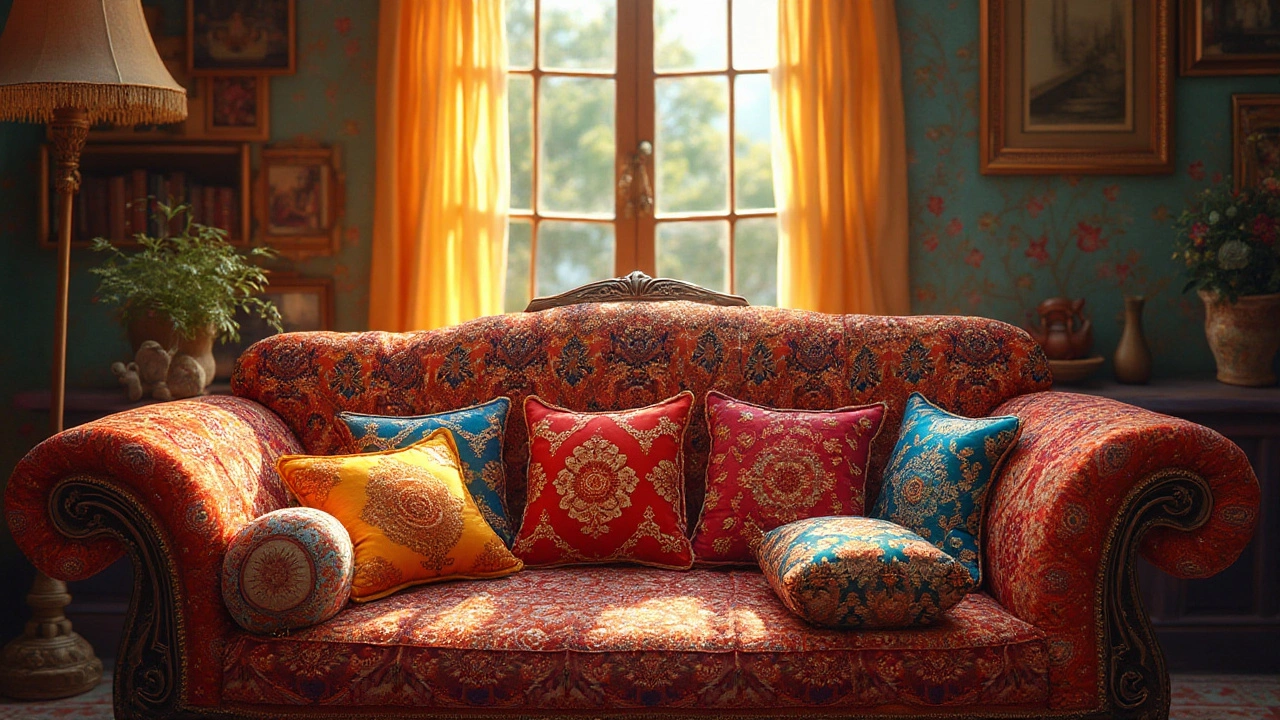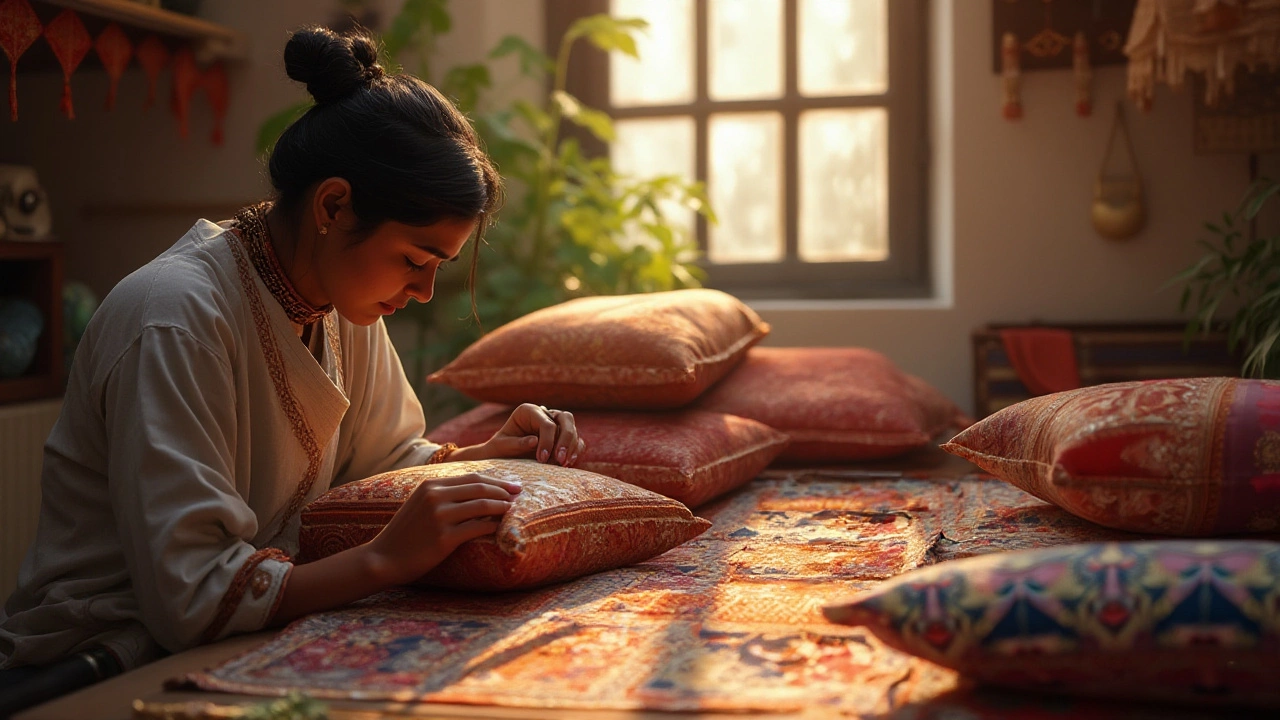Discovering Sofa Cushions: Types and Terminology

Sitting on a sofa seems like a straightforward affair, but there's plenty to uncover when you look beneath the surface—literally. Those plush, inviting pieces of furniture goodness we call sofa cushions come in various forms and functions, and they're not just about comfort.
The right sofa cushions can transform an ordinary seat into a throne of relaxation, aligning with both personal style and ergonomic needs. While many people might generically refer to them as 'cushions' or 'seats', there's a spectrum of shapes, sizes, and fillings dedicated to enhancing your lounging experience.
Dive into this exploration of sofa cushions, where you'll learn to distinguish your scatter cushions from your bolster pillows and find just the right fit for your home decor. Sprinkled with practical tips, this article is a helpful guide for anyone looking to enhance their living room's comfort and style.
- Types of Sofa Cushions
- Materials and Fillings
- Replacing and Maintaining
- Tips for Choosing Sofa Cushions
Types of Sofa Cushions
When it comes to understanding the variety of sofa cushions, it's a realm of interiors that can blend art with comfort in a harmonious manner. Each type of cushion has a unique role and contributes to both the aesthetics and the function of your seating arrangement. There’s an intricacy to the way these cushions are designed, and it's significant to recognize the various types available. Familiarizing yourself with different sofa cushions can significantly aid in tailoring your living room space to better fit personal and stylistic needs.
The primary type of cushion you'll encounter is the seat cushion. These are the foundation of any sofa and offer substantial support. Typically, they're composed of a thick foam core wrapped in softer material for ease. Seat cushions need to be firm enough to provide appropriate support, yet plush enough to offer comfort. Then, there are back cushions, which complement the seat cushions by providing additional support for your upper body. Often, they are softer than seat cushions and can vary in thickness depending on design aesthetics.
You cannot overlook scatter cushions, the decorative elements that often serve as the cherry on top for couches. These are the colorful accents that can make a significant impact on the room's ambiance. Scatter cushions are usually smaller, less structured, and can be filled with materials such as down or synthetic alternatives. They add vibrancy and personalization to a sofa’s look.
"Scatter cushions are like the jewelry that completes an outfit," says renowned interior designer Nate Berkus, emphasizing their role in adding flair and character.
Additionally, bolster cushions or lumbar pillows can be found, predominantly chosen for their ergonomic benefits. These cylindrical or rectangular cushions can offer superb back support, especially useful for those who spend prolonged periods on the sofa. Many appreciate bolster cushions for their decorative edge and additional comfort. As a bonus, many of these cushions are designed with removable fabric covers, making them easy to clean.
The selection of these couch pillows not only impacts comfort but also the aesthetic appeal. According to a recent study, households with a thoughtful arrangement of cushions tend to spend about 15% more time in their living rooms, signifying the role these elements can play in everyday life. When choosing which type to buy, it's worthwhile to consider factors such as the size and shape of your sofa, the cushion’s functional purpose, and the visual style you wish to project.
Materials and Fillings
When it comes to the world of sofa cushions, understanding the materials and fillings used is crucial for determining both the comfort level and durability of your furniture. Essentially, the combination of these elements dictates the feel and longevity of the cushions you’ll be spending countless evenings upon. Let's begin with the fabrics that encase these cushions. Common upholstery material choices range from cotton, which offers a soft and breathable surface, to the more heavy-duty leather, known for its elegant and classic appeal. Then there’s microfiber, a popular pick due to its stain-resistant nature, which proves ideal for homes with pets or children.
Moving towards the fillings, it becomes a more nuanced subject. The majority of sofa cushions are filled with either foam, feather, fiber, or a combination thereof. Foam is the backbone of many cushions due to its cost-effectiveness and firm support. High-density foam, in particular, is favored for its resilience and capacity to regain shape, making it a staple in contemporary sofas. Feather fillings offer an indulgent softness that provides the ultimate in luxury, though they require regular plumping to maintain their form. Often, cushions are filled with a blend of feathers and foam to balance support with comfort.
In recent years, more environmentally-conscious choices have made their way into the market, with materials like latex foam and recycled polyester gaining popularity for their sustainability. Latex foam is derived from natural rubber and offers a buoyant and breathable experience but comes with a steeper price. Fiber fillings, often made from polyester, are a cost-friendly option that provides firmness and a pleasing bounce, yet they may compress over time, leading to a less voluminous look.
"The style of your home and the lifestyle you lead should guide your choice of cushion fillings," says Francesca Smith, an interior designer known for creating functional yet stylish living spaces.
It's interesting to consider how different cultures approach cushion fillings. In some parts of the world, bean bags and other non-traditional fillings are used, bringing a distinct flair to furniture design. The choice of materials and fillings often speaks to not just personal comfort preferences, but cultural attitudes toward relaxation and hospitality. In regions that prioritize lounging and social interactions in their daily life, cushion fillings may lean towards those that offer plush comfort, reflecting a slower, more introspective pace of living.
A good breakdown of the qualities of each filling might include specifics, such as: foam holding a dense structure; feather offering softness but needing fluffed; fiber bringing cost-efficiency but potentially sagging over time. Choosing a mix is usually a happy medium. Using this understanding, one can choose a cushion that aligns with their personal use-case, ensuring not just a beautiful aesthetic appearance but also practical comfort that enhances day-to-day living.
| Filling Type | Comfort Level | Durability |
|---|---|---|
| Foam | Medium-Firm | High |
| Feather | Soft | Medium |
| Fiber | Firm | Low-Medium |
| Latex | Medium-Soft | High |

Replacing and Maintaining Sofa Cushions
Embarking on the journey of replacing and maintaining your sofa cushions might not sound like an exciting adventure, but it's one that promises comfort and design longevity. Understanding when and how to replace these essential furnishings can make a significant difference in your living room's appeal. Over time, even the most high-quality couch pillows succumb to wear, losing their support and aesthetic value. Signs that it's time to replace them include sagging, lumps, and the inability to hold shape. Choosing the perfect replacement involves considering not just the fabric but also the material's density and resilience, ensuring your new cushions align seamlessly with your existing decor while offering unmatched comfort.
Maintenance, on the other hand, is your first line of defense against premature wear. Regular fluffing, vacuuming, and rotation can extend the life of your sofa cushions. Vacuuming weekly prevents the buildup of dust and grime that can mar the appearance and degrade fabric fibers. Fluffing is not only about aesthetics; it redistributes the filling, keeping your cushions plump and inviting. Rotating cushions periodically ensures even wear, prolonging their life. In the words of interior designer Jane Lockhart,
"Cushions are like the lipstick of your furniture, bringing color and personality to any room. Care for them like you would a prized possession."Adding these simple steps to your routine will preserve your seating's charm and comfort for years to come.
If you encounter a stain, don't panic. Address spills immediately with a clean cloth to blot out the excess before it settles in, and consult the fabric care instructions for machine washing or spot cleaning specifics. For deeper cleaning methods, consider professional services that will refresh your cushions without damaging delicate materials. While replacing and maintaining sofa cushions seems mundane, it is a conversation of sustainability and style, ensuring your seating comfort remains spot on, whether you're hosting a lively gathering or enjoying a peaceful evening at home.
Occasionally, inspecting the foam and structural integrity underneath the fabric can catch problems while they're still an easy fix. If you opt for foam replacements, choose those with higher resilience ratings to stand the test of time. Remember, high-quality foam and durable fabrics often translate to a more prolonged lifespan and an increased value of enjoyment. Such strategic investments make your living space more welcoming and harmonious. By following these guidelines and integrating these practices, maintaining a stylish and comfortable sofa is as effortless as sinking into those newly fluffed cushions at the end of a long day.
Tips for Choosing Sofa Cushions
Sofa cushions are more than just fluffy accessories; they are the backbone of any comfortable sitting experience. When choosing the perfect sofa cushions, consider factors like material, design, and functionality. These components play a crucial role in creating an inviting space that beckons you to sit back and relax. Firstly, think about the material of your cushions. Natural fabrics like cotton and wool are incredibly popular because of their breathability and comfort, making them ideal for lounging areas used frequently. Meanwhile, synthetic fibers such as polyester are robust and stain-resistant, perfect for homes with children or pets.
The next step is aligning the design of your couch pillows with your decor. The beauty of choosing cushions is the creative freedom it provides. You can play around with colors and patterns to complement your living room's theme. For a classic setting, opt for earth-toned or muted cushions. Bold and bright cushions, on the other hand, work wonders in spaces aiming for a more modern and lively aura. Combine various textures like velvet and leather for a dynamic effect. According to renowned interior designer Jane Barnes, "Textures and colors do not just affect the aesthetics of a living space—they influence the entire room's energy."
Functionality, though often overlooked, is pivotal. Knowing how your sofa is used can guide you to the right cushions. For instance, in a space primarily for entertainment and gatherings, fluffy cushions filled with down or feather blends offer unbeatable comfort. Although luxurious, these fillings can flatten quickly, demanding more maintenance. For a more durable option, consider foam or memory foam cushions which retain their shape longer. If you seek a balance between resilience and softness, a combination of foam core with a feather or fiber wrap might just be perfect. A 2022 study found that households using multi-layer filled cushions reported increased comfort in daily use.
Lastly, don't forget about the maintenance of your upholstery. Cleaning ease is a game changer, especially in high-use areas. Look for cushions with removable covers as they are easier to refresh. Stain-resistant or machine-washable fabrics simplify upkeep tremendously. It's also wise to rotate your cushions periodically to ensure even wear. People often underestimate the impact of proper cushion care on the lifespan of a sofa.